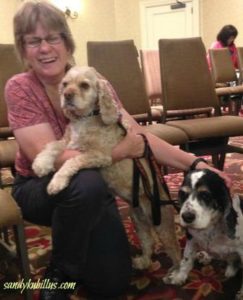You walk into the hotel with your dog by your side, feeling assured as you see other conference attendees with their pets. But your dog barks and lunges toward another dog, stretching his retractable leash to its full fifteen feet. In your scramble to hang onto the leash, your purse and conference materials scatter on the floor. You yank him hard, stopping him in his tracks as he trips. You yell, “Max come here NOW!” He cowers and everyone turns and stares at you.

Exasperated, feeling as if your tail were between your legs, you gather your stuff and leave. “You bad dog,” you mutter, blaming your dog for your not being prepared.
This could have been me at my first BlogPaws conference, but I was prepared.
Chipper, my senior black and white cocker spaniel, acts aggressively toward other dogs. He’s never been in a fight, except through a fence. But he loves to bark at other dogs.
I hadn’t intended to bring him to the conference, but my husband couldn’t take care of him on the last day since he offered to help a friend move to a new house. We were camping and hundreds of miles away from home. I felt I had no other option but to bring Chipper with me, along with his sister, Buffy.
How to prepare you and your dog for a conference
- Is your dog ready?
- Is he used to strange people petting him and different environments? Do not bring an aggressive or shy dog. Socialize your dog with obedience training, meeting strangers (kids included), meeting dogs, going into buildings, etc. You may want to bring a muzzle just in case the stress from a conference makes him unpredictable.
- Is he healthy and up to date on his vaccinations? Tell your vet you are bringing him to a conference. My vet recommended getting a Bordetella (kennel cough) vaccine.
- If your dog has an autoimmune disease or has his immunity suppressed from chemotherapy or other drugs—do not bring him to the conference or at least do not let him interact with other dogs. My springer, Cassie, developed an autoimmune disease a few days after attending an agility trial with hundreds of dogs. Her disease wasn’t contagious, but was it coincidental?
- What is your role at the conference and what will you do with your pet?
- Are you exhibiting?
- Can your pet lie quietly in a crate at your booth?
- Can he relax knowing you are close by as you talk to people?
- Are you using him for a demonstration (treats, cleaning products, etc.)?
- Your pet may tire quickly from this task and need to take frequent breaks. A crate will help let him rest.
- Are you using him as an attention grabber to draw people to your booth?
- This frequently occurs at shows that involve children. Again, have a well socialized pet, bring his crate and take frequent breaks.
- Are you attending presentations and speaking with exhibitors?
- If your pet can relax, they can sleep at your feet, on a chair, or in a stroller during the talks—which is the best as long as he doesn’t snore!
- At the conference where I took both Chipper and Buffy, I sat off to the side and in the back—away from all the other dogs.
- Meeting exhibitors can be very stressful for your pet where there are a lot of people, noises and smells in close proximity. Small dogs may worry about being stepped on.
- Use a stroller for a small dog so he feels protected.
- Do not use a retractable leash—use a 4 or 6-foot leash to hold him close to you. If he is feeling threatened or nervous, stay out of the exhibit hall and take him for a walk outside to de-stress.
- Bring a large bag to hold all your conference materials, dog gear, and exhibitor handouts. Trying to hold all your stuff and control your dog can be challenging.
- Are you speaking or do you have a role where you cannot pay attention to your dog for a period?
- Have a friend take care of him during that period or use a crate and place him where he can see you but is away from the action.
- Can you leave him in a crate in the hotel room, or at doggy daycare if provided? Do not put him in your car if it is sunny or warm.
- What will you do with your pet during meals?
- Find a seat ahead of time in an area where your pet will not be in the way. If there is a buffet line, try to find someone at your table that can hold your dog’s leash while you stand in line. Don’t tie the leash to a chair or table that he could possibly move.
- As I tried to balance my plate while holding both leashes, I was fortunate that a server stepped in and held Chipper and Buffy while I loaded my plate—thus avoiding spilling everything!
- Don’t feed your dog from the table, even if that happens at home.
- Don’t let them sit on a chair! Hopefully he will go under the table and take a nap.

- Find a seat ahead of time in an area where your pet will not be in the way. If there is a buffet line, try to find someone at your table that can hold your dog’s leash while you stand in line. Don’t tie the leash to a chair or table that he could possibly move.
- If your pet can relax, they can sleep at your feet, on a chair, or in a stroller during the talks—which is the best as long as he doesn’t snore!
- Can your pet lie quietly in a crate at your booth?
- Are you exhibiting?
- Take frequent potty breaks. Remember your dog is nervous and may have to go more often. There’s nothing more embarrassing than having your dog piddle, or worse, poop on the hotel rug. Bring plenty of poop bags and find the potty area before your dog needs it.
- Bring a collapsible water dish and water bottle. You drink a lot of water at conferences and so will your pet. Offer him water often.
- Bring your own treats and snacks. Save the exhibitor handouts for later when your dog is more relaxed. The last thing you want to do is upset his tummy and deal with the consequences.
Our pets want to be with us all the time, but sometimes it’s stressful for them and us. Think out every scenario and be prepared to make this a great experience for both of you!
Please leave a comment and share this post.
This is a Wordless Wednesday blog hop. Please visit the other posts.



I think I want to bring Sophie with me to next year’s Blog Paws. I have a good friend who lives nearby IF she can’t handle herself, but I think we’ll be OK. She loves everyone but does have a hard time staying calm on her leash when spotting a possible friend across a room. These are all great tips.
These are great tips. I think the most important one is “Is your dog ready?” I think that could transfer to a cat as well. I know for a fact my cats are not ready for a conference and I wouldn’t expose them to that right now. Hopefully some day they will be!
Now this is useful for people who have never been before!
Our cats are not keen on company, but I know some cats are seasoned veterans of BlogPaws!
Very useful tips. Conferences are new surroundings with lots of people and noise and so that can scare dogs easily. Very imp to keep them calm and well fed.